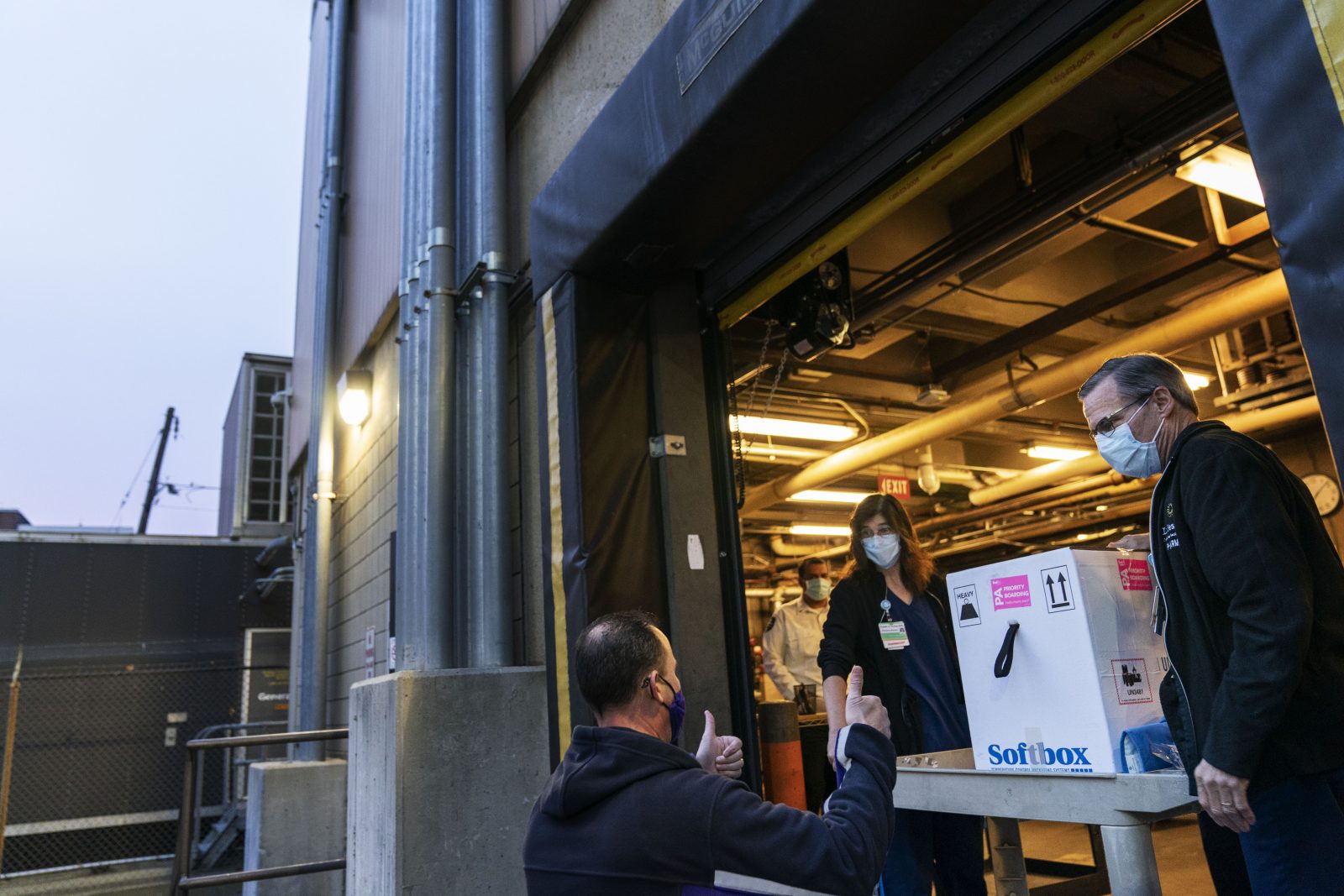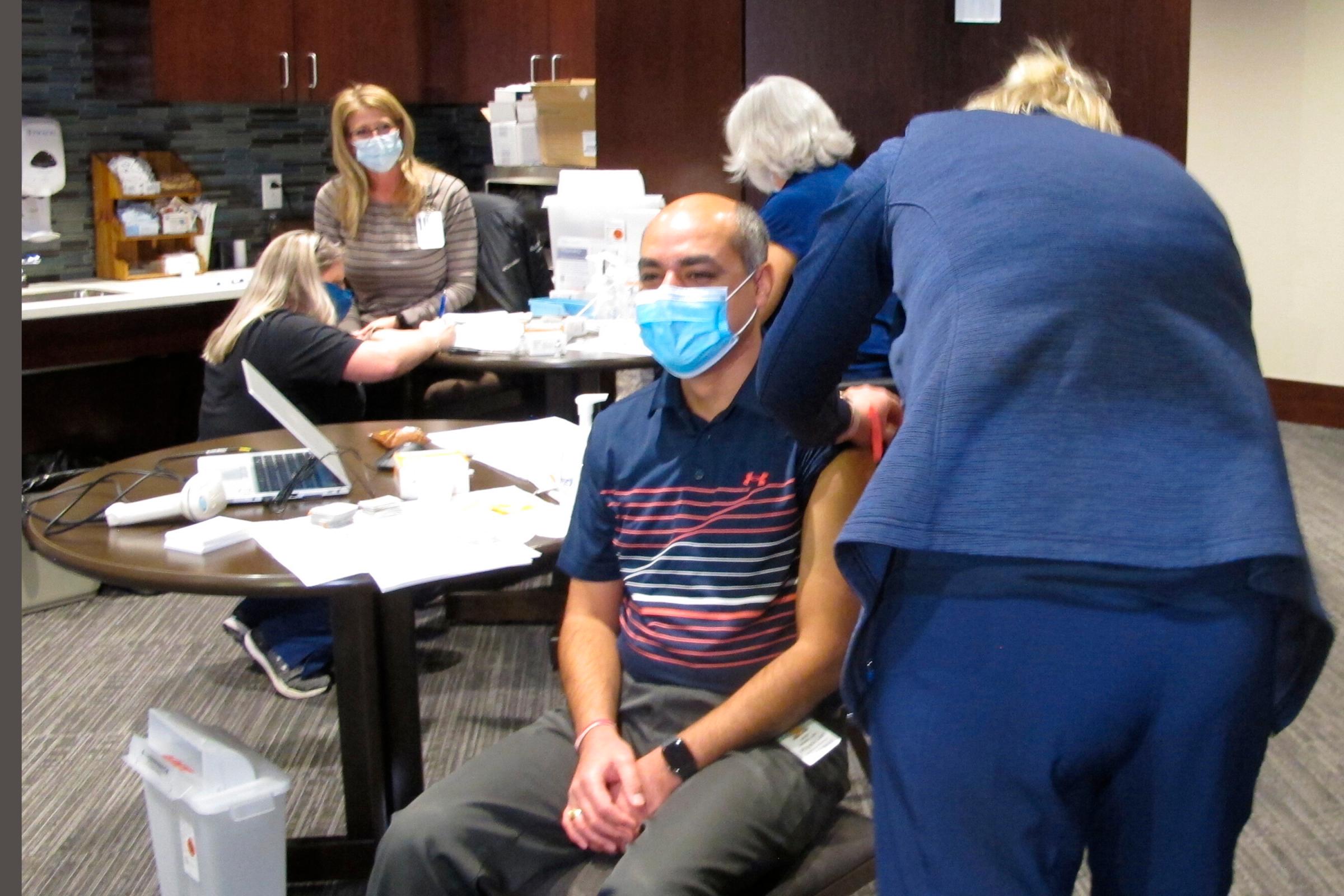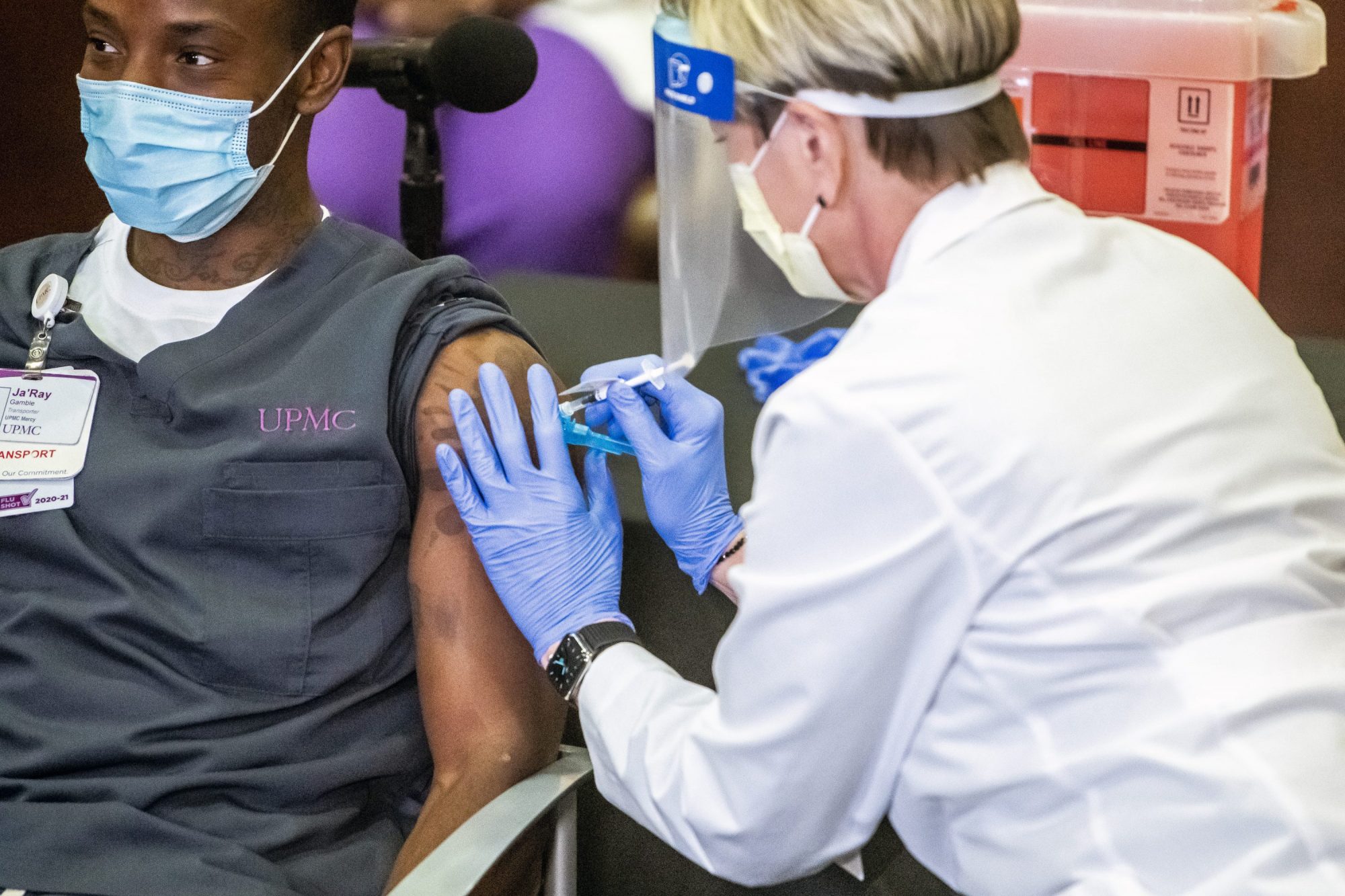Just before 9:30 a.m. on Monday, Sandra Lindsay, an intensive care nurse at Long Island Jewish Medical Center in Queens, New York, became one of the first people to get vaccinated against COVID-19.
The jab was the highly anticipated start of what public health experts hope is a nationwide wave of vaccinations that will signal the beginning of the end of the pandemic. The news coincided with a dark new milestone for the country—more than 300,000 confirmed COVID-19 deaths.
Only one vaccine, from Pfizer-BioNTech, has received emergency use authorization from the Food and Drug Administration to begin shipping. Another vaccine, from Massachusetts-based biotech Moderna, is up for review later this week.
Read more: More Than 300,000 People in the U.S. Have Died From COVID-19
Many hospitals turned the first jabs into a media opportunity, documenting on video the otherwise routine vaccination. But, the seemingly simple process belied a herculean logistical effort to make it happen—one that may still have kinks to be worked out over the coming days and weeks as more doses are delivered and people start receiving the second of the two-dose regimen about a month later.
First, the limited number of doses means that there won’t be enough to vaccinate even the first priority groups of healthcare workers and people living in long term care facilities. States asked hospitals, health facilities and providers to submit requests for doses, and allocated shots based on factors including the most urgent need, the ability to store the vaccines properly and the ability to use all of the first doses quickly. The Pfizer-BioNTech vaccine relies on a new technology based on mRNA, which needs to be stored frozen at ultra-cold temperatures that only specially designed freezers can reach, so facilities that have these freezers are more likely to receive the vaccine first.

Next, Pfizer is shipping the vials in customized containers, called “pizza boxes”—because of the physical resemblance to a small pie—which contain a minimum of 975 doses. For health systems that won’t need that many doses, governors in at least 26 states and territories have called on the National Guard to help with breaking up the shipments, distributing and driving the doses to healthcare providers.
As for deciding who among the health care workers will get inoculated first—most hospitals are relying on guidelines from their state health departments and the Centers for Disease Control and Prevention (CDC), which advise concentrating on those providing care to COVID-19 patients first. Even among this group, hospitals are generally not mandating the vaccine, however, but are instead asking their staff to make their own decisions about getting vaccinated.
Read more: Here’s Who the CDC Says Will Get the COVID-19 Vaccine First
The vaccine is not approved as a fully licensed medical product, but authorized under emergency use, which means that data on its long term safety and effectiveness isn’t as robust as that of an approved product. As a result, some health workers may decide to wait before getting vaccinated.
Here’s how the first vaccines were distributed across the country.
Northwell Health (New York)
It’s somewhat appropriate that the first person in the country to get vaccinated against COVID-19 is a New Yorker, since New York City was an early hot spot for the pandemic last spring. Northwell Health, a 23-hospital health care system in the New York-area that includes Long Island Jewish Medical Center, received several thousand doses of the vaccine at 7 a.m. Monday, and was ready to begin vaccinating hours later. Dr. Mark Jarrett, chief quality offer and deputy chief medical officer at Northwell, says the hospital system purchased nine ultra-cold freezers to store vaccines. Eventually, when more doses become available, it will also store vaccine for smaller facilities that can’t purchase or rent the freezers.
Read more: One Month Inside a New York Hospital Battling Coronavirus
Northwell’s 74,000 employees will be vaccinated according to their risk of infection, says Jarrett. And the priority list also includes backups in case people aren’t able to get vaccinated (if they have a fever or need to cancel their appointment) so that no doses go to waste.
“In terms of who gets the vaccine, we developed a matrix based on people’s job function, which hospital they are in—because some areas have more prevalence [of COVID-19]—and their age,” he says.
Managers are also staggering vaccinations so not everyone in a group is vaccinated on the same day, in case they develop side effects (the most common are fever, muscle aches and fatigue) and need to take a day or two off work.
University of Maryland Medical System (Maryland)
The University of Maryland Medical System purchased six ultra cold freezers and rented several more to ensure they had enough storage space for the Pfizer-BioNTech vaccines. The first batch of 975 doses arrived on Monday morning.
Senior director of pharmacy Joseph Di Cubellis, says that his team has been trained to manage the vials, which, because of the temperature requirements, must be placed back in the freezers within three minutes after they are removed if they aren’t going to be used. If they are going to be used, they can remain in a refrigerator for up to 120 hours.
Once vials are removed from the freezer and replaced, they can’t be taken out again for another two hours. That means pharmacists need to be on top of how many vaccines they will be giving, and ensure that they defrost the right number at the right time. What happens if some people don’t show for their vaccine appointment, or change their mind?
Read more: Pfizer’s Vaccine Must Be Stored at -70° C. Here’s What to Know
“At the end of the day, we have an on-call procedure to get someone down to get vaccinated to make sure that if that last dose wasn’t needed or someone canceled their appointment, that we have someone else to fill in so we can use the entire amount of doses,” says Di Cubellis.
Employees were asked whether they wanted to get vaccinated, and about 60% expressed an interest, while 40% were more hesitant, says Gary Tuggle, deputy incident commander for the health system. Like other hospitals, on Monday University of Maryland Medical System began vaccinating those at highest risk of exposure to COVID-19 first, including food service and environmental service workers, as well as physicians and medical staff in COVID-19 wards.
The first employee to get vaccinated was Shawn Hendricks, a nurse who oversees several units that care for COVID-19 patients. “I want my family and I to be safe from getting COVID,” she said in a statement. “Unless people start to get vaccinated, I think this pandemic will last longer, and get worse.
Sanford Health (North Dakota)

A few minutes before 7 a.m. on Monday, Jesse Breidenbach, senior executive director of pharmacy at Sanford Health, got a text informing him that Pfizer’s COVID-19 vaccines were out for delivery on a truck in Fargo, N.D. Within 10 minutes, a colleague called to tell him nearly 3,000 doses had arrived. “It was a little bit of an early-morning surprise,” Breidenbach says, since he thought they might arrive as late as 10:30 a.m.
About five hours after delivery, frontline workers from Sanford Health began getting vaccinated against COVID-19. By day’s end, roughly 150 people had been vaccinated in Fargo, with hundreds more on the schedule for Tuesday, split up between Sanford Health sites in Fargo, Bismarck and Sioux Falls, S.D.
It all happened fast, but Breidenbach says Monday was the culmination of months of planning. Back in August, Sanford decided to buy four ultra-cold freezers needed to store the Pfizer-BioNTech vaccine at -70℃. In September, it bought two more. At the time, it wasn’t clear whether the hospital system would actually need that many, with plenty still to learn about COVID-19 vaccines. But “we’re certainly happy that we did purchase them,” Breidenbach says. “It really feels like we’re able to start taking action directly against the pandemic for the first time.”
Lifespan (Rhode Island)
Dr. Christian Arbelaez, an attending emergency room physician at Rhode Island Hospital, became the first employee from Lifespan, the Ocean State’s largest health system, to get a COVID-19 vaccine. Lifespan received 2,000 doses of Pfizer’s vaccine on Monday, and is expecting another 1,000 on Tuesday.
Dr. Karen Tashima, an infectious disease physician at one of Lifespan’s hospitals, says a clinic was ready to begin administering doses as early as Saturday. Employees ended up having to wait a little longer than that, but 10 Lifespan staffers were vaccinated Monday morning, and another 125 were set to receive the vaccine Monday night.
Employees from the system’s emergency rooms, intensive care units and COVID-19 wards—including doctors, nurses, secretaries and maintenance staffers—are eligible for the very first doses. Tashima says she signed up for a time slot on Sunday. “Some of my staff got the email [allowing them to sign up] today, and one of them said she was nearly in tears,” Tashima says.
University of Pittsburgh Medical Center (Pennsylvania)

At 9:15 a.m., the hospital’s allotment of 975 doses of COVID-19 vaccine were delivered by UPS. By 11 a.m., five health care workers, including a surgical nurse, an ICU nurse, a transporter (who helps to move patients around the hospital for testing and other procedures) and an environmental services employee, were vaccinated during a live-streamed press briefing. “I’m in the COVID pods every day, to help clean and check stuff, so [getting vaccinated] puts me at ease that I have an extra layer of protection vs. the PPE that we wear. That shot puts my mind at ease a little more,” Manny Philavong, who works in environmental services at UPMC, said.
The hospital expects to administer all of its doses of the vaccine this week. The first to get the jab are those with the highest risk of exposure to infection, including those working directly with COVID-19 patients, says Tamim Minnier, chief quality officer at UPMC who is also a registered nurse and administered all five of the initial vaccinations. As with many other hospitals, UPMC is not aware of when the next shipment of vaccines will arrive. “We hope over the next week or two we will be receiving additional doses,” she said.
UT Southwestern Medical Center (Texas)
In the first week of vaccination alone, the UT Southwestern Medical Center in Dallas is supposed to receive 5,850 doses—one of the largest allotments in Texas. Unlike many institutions, UT Southwestern has enough ultra-cold freezers to handle large shipments of the Pfizer-BioNTech vaccine. Doses are set to arrive Tuesday morning, according to a hospital spokesperson.
Dr. Trish Perl, UT Southwestern’s chief of infectious diseases, says the hospital prioritized employees for early vaccination based on their exposure not only to COVID-19 patients, but also to patients at risk of developing severe cases of coronavirus if infected, such as those on the geriatrics or bariatrics wards.
Each department head was asked to draw up a list of employees they’d like to get vaccinated early. For her staff, Perl submitted people likely to be on service shortly after the vaccines arrived, as well as those working in high-risk units like the COVID-19 ward. (She also has backup staffing plans in place, in case anyone develops side effects from the vaccine that force them to call out sick for a couple days.) “Those lists go into a big black box, and then after that I don’t really know how they’re determining it,” Perl says.
She says employees will likely receive messages through their electronic health records, prompting them to agree to receive the vaccine and provide certain health information. They’ll then receive a time and place for vaccination. “It’s not like we can just line up and get our arms jabbed,” Perl says. “With an emergency-use authorization, there is an informal consent process that goes on.”
University of California, Irvine (California)
At University of California Irvine, doctors are watching the first vaccinations with a bit of envy. Their first shipment of 3,000 doses should arrive on Wednesday, and they are ready to start working through their list of priority health care workers from among the 15,000 on staff. “We are planning on administering all 3,000 doses within the first couple of days,” says Dr. Nasim Afsar, chief operating officer at UC Irvine.
Mangers are also planning on vaccinating only about 25% of any unit to make sure that if people experience side effects, and need to miss work, that staffing won’t be affected.
MD Anderson Cancer Center (Texas)
As a cancer center that cares for patients who are immunocompromised because of their treatments, MD Anderson in Houston received 4,785 doses at 7 a.m. on Monday morning. “We are prepared to dispense the entire supply to our frontline health care workers through next week,” says Dr. Welela Tereffe, chief medical officer at MD Anderson.
The hospital will hold its first vaccination clinic on Wednesday. Within 24 hours after a sign up system was launched, a quarter of the doses were claimed. Tereffe says the vaccination is voluntary, and more than 80 nurses have volunteered to administer the vaccine.
Because the studies on the Pfizer-BioNTech vaccine showed that some people experienced mild side effects from the two-dose shot, especially after the second injection, Tereffe says managers are working with their teams to stagger when people get vaccinated so that if anyone needs to take off of work to recover, patient care won’t be affected.
While they are hopeful for more vaccine doses in the coming weeks, Tereffe notes that most people in the U.S. are still far from enjoying the protection that the shots can provide.
“Whether you are vaccinated or not, we need to continue to adhere to masking, social distancing, and hand washing to keep one another safe for many more months to come, before public health experts advise us to discontinue these activities,” she says. “These things are much more important for the broader public right now than being vaccinated since supply is currently limited.”
More Must-Reads from TIME
- Donald Trump Is TIME's 2024 Person of the Year
- Why We Chose Trump as Person of the Year
- Is Intermittent Fasting Good or Bad for You?
- The 100 Must-Read Books of 2024
- The 20 Best Christmas TV Episodes
- Column: If Optimism Feels Ridiculous Now, Try Hope
- The Future of Climate Action Is Trade Policy
- Merle Bombardieri Is Helping People Make the Baby Decision
Write to Jamie Ducharme at jamie.ducharme@time.com and W.J. Hennigan at william.hennigan@time.com